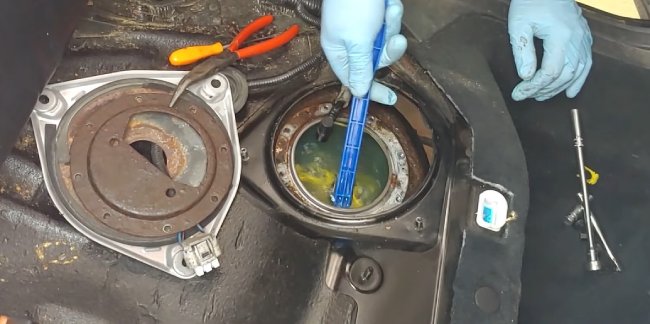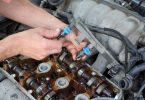Most people don’t consider how to clean a fuel tank until they need to. For all its worth, cleaning your fuel tank is essential if you want to keep your engine running smoothly; and with the right tools and knowledge, it can be done relatively easily. If the need to clean a fuel tank arises, it is most likely due to a problem with the fuel pump or fuel injectors.
Cleaning a fuel tank can be a difficult and dangerous task, especially if the tank is large or in an awkward location. However, there are some methods for cleaning a fuel tank without removing it from its location. This article will explore these methods and offer tips on how to effectively clean a fuel tank. First and foremost, let us investigate the symptoms of dirt in a fuel tank…
- Inadequate acceleration
As dirt accumulates, it settles at the bottom, reducing the amount of fuel emitted from the tank. As a result, the vehicle in question will more than likely begin to slow down when accelerating.
- Problems starting the engine
When the tank is clogged with dirt, the fuel will not ignite when the car is started. Furthermore, when the engine is running, harmful fumes and gases are produced.
- The engine shuts down
The contamination of fuel with dirt will quickly cause the engine to shut down. Every now and then, the car will break down. The engine oil will also begin to collect dirt and become contaminated.
- Incorrect reading on the gas gauge
When the fuel tank is clogged with dirt, the fuel gauge reads incorrectly. As a result, it’s difficult to tell how much fuel the car has used.
- Motor overheating
The accumulation of dirt can cause the motor to overheat. This is because contaminated fuel will not reach the combustion chamber in time, causing more friction between motor parts and possibly causing the motor to overheat.
Fuel tank cleaning
Before you begin cleaning your fuel tank, you’ll need the following items:
- Cleaner for the fuel system
A fuel system cleaner is a chemical spray used to clear clogged fuel pipes. This spray will dissolve dirt and clean the pipes, restoring smooth fuel flow in your car’s engine.
- Socket set
This is a set of sockets for removing the fuel lines from your fuel tank. A socket will be required if you need to clean one of the lines. It is recommended that you use the original sockets designed specifically for cleaning fuel tanks.
- Cleaning substance
You’ll need a cleaning product to get rid of the filth in your tank. It is advised that the cleaning agent be a liquid of some sort that won’t corrode the metal in your tank.
- Fuel Can
You can clean your gasoline tank using gas if a cleaning solution is not easily accessible on the market. The dirt will be burned off by the gas, which is contained in a compact container and makes it simple to remove.
- Towel
An essential tool for cleaning your gasoline tank is a towel. You will need a towel to clean up the extra fuel and grime that will be in your tank after cleaning it. However, you must make sure that your chosen towel is sturdy enough.
A Step-by-Step Guide to Cleaning a Fuel Tank

Once you’ve gathered all of your tools, it’s time to clean your fuel tank. Here’s a step-by-step guide to cleaning your fuel tank without having to remove it.
- Disconnect all fuel tank lines
The first step is to disconnect all fuel lines that are attached to your fuel tank. This will reduce the amount of dirt and fuel in your tank, making cleaning it easier.
- Gain access to the tank
After you’ve disconnected the lines from your tank, you’ll need to figure out how to get to it. In this case, you must first remove the bolts that are holding your fuel cap in place, and then separate the cap from the hose that is attached to it.
- Empty the fuel tank
After removing the fuel cap and disconnecting all fuel lines, drain the fuel tank. To do so, open the fuel valve on your vehicle and remove the fuel tank cap. The fuel tank will be depleted in no time.
- Apply a degreaser diluted with hot water
To clean your tank effectively, use a degreaser mixed with hot water. The solution should be 70% degreaser and 30% hot water. If you do not use the proper proportions, you will end up using more cleaning agent, which may harm your fuel system because it contains acids and alkalis. Furthermore, it is recommended that you allow the mixture to sit for a few hours before rinsing.
- Use a high-pressure water gun to rinse the tank
After draining the tank, you’ll need to check for any leftover dirt and fuel, which you can only do with a high-pressure water gun. In any case, you won’t be able to see all of the dirt inside your fuel tank.
- Wipe the tank dry with a dry towel
Wipe all of the excess water off your tank with a dry towel. This will protect your tank from any rust.
- Allow your fuel tank to dry in the open air
After successfully cleaning and rinsing your fuel tank, set it aside to dry. This will help to prevent water from mixing with fuel, which could result in another similar process.
- Replace your fuel cap
After cleaning and rinsing your tank, reconnect all of the lines that were disconnected prior to accessing your tank.
The Advantages of Cleaning Fuel Tanks at the Appropriate Time
- Makes the cleaning process easier in the future
Regular cleaning of the fuel tank will keep carbon and dirt at bay. This will prevent the accumulation of solid fuel, also known as varnish. It is difficult to clean your tank when there is a solid buildup of fuel.
- Guards against engine damage
You can avoid engine breakdowns by cleaning your tank on a regular basis. The buildup of dirt and carbon in your engine can cause it to fail sooner rather than later.
Caution: A dirty fuel tank has a negative impact on the fuel system components and the overall performance of the vehicle. Because cleaning a fuel tank is a complicated process, you should seek the assistance of a professional mechanic. Before refilling the tank with fuel, make sure it’s completely dry and there’s no water inside.
To sum up
A clean fuel tank is critical to your vehicle’s performance. Most importantly, a clean fuel tank is a recipe for increased fuel efficiency and vehicle performance. As a result, you must use the proper tools and chemicals because ineffective cleaning agents can damage your fuel system.
FAQs
Q. What will happen if I do not clean the Dirty Gas/ Fuel Tank?
Ans: An unclean gas/fuel tank will contaminate the fuel system components over time, causing damage to the fuel lines, carburetor, and other fuel system equipment. It can also degrade the performance of your engine and cause problems starting your vehicle
Q. What is the cost of flushing a fuel tank?
Ans: It can cost up to $300, depending on the type of vehicle. Furthermore, the cost varies according to the complexity of the fuel tank system.










Leave a Comment